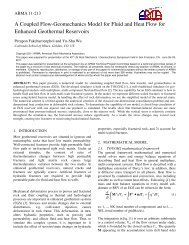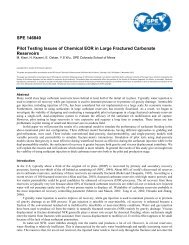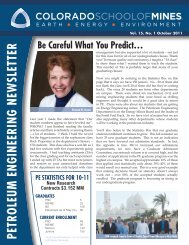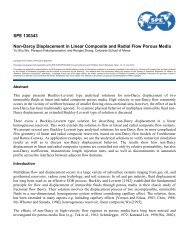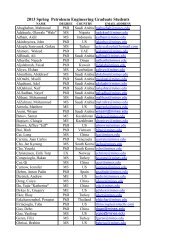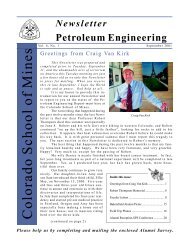Researchers - petroleum engineering colorado school of mines
Researchers - petroleum engineering colorado school of mines
Researchers - petroleum engineering colorado school of mines
Create successful ePaper yourself
Turn your PDF publications into a flip-book with our unique Google optimized e-Paper software.
Petroleum Engineering DepartmentFall 2011ResearchPETROLEUMENGINEERING
Petroleum Engineering @ CSM• CSM Facts– Located in Golden, Colorado – foothills <strong>of</strong> the Rockies– 4000 undergraduates, 1440 graduates• Petroleum <strong>engineering</strong>– 13 research / teaching faculty– $3.2MM new research funding in FY 11– Active research projects in• Carbonate reservoir characterization• Enhanced oil recovery• Unconventional oil and gas• Hydraulic fracturing• Pore-scale physics and flow• Drilling• CO 2 sequestration• GeothermalPETROLEUMENGINEERING
PE Research / Teaching Faculty• Linda Battalora(lbattalo@<strong>mines</strong>.edu)• Alfred Eustes(aeustes@<strong>mines</strong>.edu)• Ramona Graves(rgraves@<strong>mines</strong>.edu)• Todd H<strong>of</strong>fman(th<strong>of</strong>fman@<strong>mines</strong>.edu)• Hossein Kazemi(hkazemi@<strong>mines</strong>.edu)• Mark Miller(mmiller@<strong>mines</strong>.edu)• Jennifer Miskimins(jmiskimi@<strong>mines</strong>.edu)• Erdal Ozkan(eozkan@<strong>mines</strong>.edu)• Manika Prasad(mprasad@<strong>mines</strong>.edu)• Azra Tutuncu(atutuncu@<strong>mines</strong>.edu)• Craig Van Kirk(cvankirk@<strong>mines</strong>.edu)• Yu-Shu Wu(ywu@<strong>mines</strong>.edu)• Xiaolong Yin(xyin@<strong>mines</strong>.edu)PETROLEUMENGINEERING
PE Research Centers and Institution• CEMMC – Center for Earth, Materials, Mechanics,and Characterization (Graves / Miskimins)• MCERS – Marathon Center <strong>of</strong> Excellence forReservoir Studies (Kazemi / Ozkan)• UNGI – Unconventional Natural Gas and Oil Institute(Tutuncu)PETROLEUMENGINEERING
PE Faculty and ResearchWhat is in this book?• Alfred Eustes – Drilling for<strong>petroleum</strong> & non-<strong>petroleum</strong>activities• Ramona Graves – Rock andCEMMC• Todd H<strong>of</strong>fman – EOR for shale oil,Geologically realistic reservoirmodeling• Hossein Kazemi – IOR/EOR,reservoir studies at MCERS• Jennifer Miskimins – Stimulationand FAST consortium• Erdal Ozkan – Well testing /MCERS• Manika Prasad – Petrophysics <strong>of</strong>Organics, Clay, Sand, and Shale• Azra Tutuncu – Geomechanicsand unconventional gas• Yu-Shu Wu – CO 2 -EOR, CO 2sequestration, geothermal,hydrology• Xiaolong Yin – Pore-scale physicsand flow, phase behavior,suspensionPETROLEUMENGINEERING
Alfred William (Bill) Eustes III• Raised in southeastern US– Born in Florida– Graduated Ben Eielson High School (Alaska)• Education– BS ME, Louisiana Tech University, 1978– MS ME, University <strong>of</strong> Colorado, Boulder, 1989– Ph.D. PE, Colorado School <strong>of</strong> Mines, 1996• Employment– ARCO Oil and Gas Company (June 1978 - April 1987)• Senior Drilling Engineer• Senior Production/Facilities Engineer– Colorado School <strong>of</strong> Mines (April 1996)• Associate Pr<strong>of</strong>essor– Consultant• Ponderosa Associates• BP Alaska• Sklar Exploration• Fleckenstein, Eustes, and AssociatesPETROLEUMENGINEERING
Other Things About Me• ASME IPTI - Petroleum Division– Executive Committee member – sevenyears– Chair <strong>of</strong> the Division• NSF– Technical Advisory Board member forIce Coring and Drilling• NASA– Martian drilling operations– Astrobiology project reviewer• Chapter co-author– Drilling in Extreme Environments– SPE Petroleum Engineering Handbook• General Engineering– SPE Drilling Engineering Textbook• Drilling fluids• Drilling problems• Society <strong>of</strong> Petroleum Engineers• American Association <strong>of</strong> DrillingEngineers– Student chapter faculty advisor• International Association <strong>of</strong> DrillingContractors• Sigma Xi• Civil Air Patrol• CSM– Undergraduate CoordinatorPETROLEUMENGINEERING7
CoursesUndergraduatE– PEGN 311 – Drilling Engineering– PEGN 361 – CompletionEngineering• Other classes– PEGN 315 – Field Session I– CSM 101 – Freshman SuccessSeminar– HNRS 312 – Foreign Area Study– HNRS 402 – McBridePracticum: Foreign Area StudyField TripGraduate• PEGN 502 – Advanced DrillingFluids (and Cement)• PEGN 517 – Drilling EngineeringPrinciples• PEGN 594 – Directional andHorizontal Drilling• PEGN 595 – Drilling Operations• PEGN 596 – Advanced Well Control• PEGN 597 – Tubular Design• PEGN 598 – Underbalanced Drilling• PEGN 598 – Well PlanningPrinciples• PEGN 603 – Drilling ModelsPETROLEUMENGINEERING
DRILLING Research Projects 1992 toDate• Yucca Mountain Project– Vibratory Core Rod Simulator– Deviation Control Simulator– PDC Bit Frequency Analysis– Air Coring and Drilling Simulator– Fuzzy Logic Controller• Hanford Project– Resonant Sonic Drilling Simulator• Cougar Tool Project– Wave Propagation (Jarring)• Other Projects– Buckling in Curved Hole Project• DOE/BLM/USFS– Directional Drilling in the Rocky Mountains– Geothermal Drilling Risk Analysis• OMV– Benchmarking Drilling Operations• Ice Coring Project (NSF)– Review <strong>of</strong> US Ice Coring Operations– Next Generation Ice Core Rig– ICECUBE (South Pole Station)– Rapid Access Drill– Lake Vostok Penetration– Replicate Ice Coring• Jet Propulsion Laboratory Project– Drilling State <strong>of</strong> the Art Review– Prototype Bit Testing– Minimum Mass Flowrate– Autonomous Drilling Operations• NASA– In-situ Resource Acquisition– Asteroid/Lunar Drill Systems• Proposed– Real Time Drilling Analysis• RPSEA• Saudi Aramco• Rocky Mountain Operators– Geothermal DrillingPETROLEUMENGINEERING
Ice Coring and Drilling ServicesPETROLEUMENGINEERING
PETROLEUMENGINEERINGMars
PDC Bit Frequency SpectrumPETROLEUMENGINEERING15
MD [m]-16-8-4-2-1-0.5-0.25-0.12500.0156250.06250.1406250.250.3906250.56250.7656251Cummulative Deviation [h]OMV Drilling Benchmarking4321005001000150020002500Planned Runing Time [h]0 50 100 150 200 2500-10-20-30-40-50-60-70Act Runing TimePln Runing TimeLag TimeTotal for:All OperationsAvr Deviation: -0.53425926Accuracy: 0Avr Miss: 0.53425926• Use real time rig operational data stream• Historical• Real time• Determine optimal drilling parameters• WOB, N, Q, MSE, etc.• Determine precursor information• Disaster avoidancePETROLEUMENGINEERING
Drilling Education, Research, andService• Courses– What do you want?• Research - Open to opportunities– Structural analysis– Real time vibrational analysis– Geothermal activities– FEM– Acoustic analysis• Service– AADE, SPEPETROLEUMENGINEERING
Dr. Ramona M. GravesDepartment Head& Pr<strong>of</strong>essorrgraves@<strong>mines</strong>.eduColorado School <strong>of</strong> MinesPetroleum Engineering DepartmentGolden, Colorado 80401 USAPETROLEUMENGINEERING
My PhilosophyIn order for use to stay a top quality graduateprogram…we must keep faculty - they are committed toboth research and teaching.… we have to have quality graduate students.… we must create a graduate environment <strong>of</strong>scholarship, pr<strong>of</strong>essionalism, and become agraduate “community”.PETROLEUMENGINEERING
• EducationMy Background– Bachelors in Math and Physics – Kearney State College (Nebraska)– Doctorate in Petroleum Engineering – Colorado School <strong>of</strong> Mines• Pr<strong>of</strong>essional experience– 2007 – Present Department Head <strong>of</strong> Petroleum Engineering, CSM– 2006 – Present Co-Director Center for Earth, Materials, Mechanics, andCharacterization, CSM– 2004 –Present Pr<strong>of</strong>essor, Department <strong>of</strong> Petroleum Engineering, CSM– 1986 – 2004 Associate Pr<strong>of</strong>essor, Department <strong>of</strong> Petroleum Engineering, CSM– 1981 – 1986 Assistant Pr<strong>of</strong>essor, Department <strong>of</strong> Petroleum Engineering, CSM– 1978 – 1980 Petroleum Engineer, Resource Services International, Denver, CO– 1973 – 1977 High School Math Instructor, NebraskaPETROLEUMENGINEERING
TeachingClasses currently teaching:• PEGN 308 Rock Properties• PEGN 413 Formation Evaluation and Gas Measurement LabClasses taught in the past:• PEGN 310 Fluid Properties• PEGN 316 Massadona Field Session• PEGN 439 Senior Multidisciplinary Design• PEGN 503/504 Integrated Exploration and Development• PEGN 508 Advanced Rock PropertiesPETROLEUMENGINEERING
Research Overview• Multidisciplinary Reservoir Characterization• Laser/Rock Interaction• Energy and Energy EngineeringPETROLEUMENGINEERING
RESERVOIR CHARACTERIZTIONCoresIlliteROCKSKaolinitePETROLEUMENGINEERING
Example (1) Research ProjectsSENSITIVITY STUDY OF FLOWUNIT DEFINITIONBY USE OF RESERVOIRSIMULATIONbyAnne-Kristine StolzSPE 84277PETROLEUMENGINEERING
Example Flow UnitsModel 1-homogeneousModel 2- GRModel 3-FZIModel 4-r35Model 5-PcModel 6-kh/fhModel 7-SMLPPETROLEUMENGINEERING
RF (%)Results706050403020100BaseCaseModel 1-homogeneousModel 2-GRModel 3-FZIModel 4-r35Model 5-PcModel 6-kh/phihModel 7-SMLP0 0.5 1 1.5 2 2.5 3Injected PVRecovery Factor versus Injected Pore VolumePETROLEUMENGINEERING
Conclusions• Numerical simulation is important to confirm the flowunit assignment <strong>of</strong> a reservoir, in order to avoidinaccurate prediction <strong>of</strong> flow performance.• Results <strong>of</strong> the numerical simulation are a strongfunction <strong>of</strong> geologic model flow unit definitionmethod.• Best correlation for a reservoir has to be establishedindividually, based on data available.PETROLEUMENGINEERING
Example (2) Research ProjectsDETERMINING THE BENEFITS OFAPPLYING “STARWARS “ LASERTECHNOLOGYFOR DRILLING AND COMPLETINGOIL AND GAS WELLSSpecial thanks to former studentsDarien O’Brien, Samih Batarsh, Bailo Suliman, ZaneGordon, Kristina LoopPETROLEUMENGINEERING
Quote"Drill for oil? You mean drill into theground to try and find oil? You're crazy.”-- said to Col. Drake when hetried to enlist support for hisproject to drill for oil in 1859.PETROLEUMENGINEERING
Laser-Rock InteractionEmitted BeamReflected BeamIncident Laser BeamScattered BeamRockAbsorbed BeamPETROLEUMENGINEERING
Berea Sandstone CT ScanSample ID: OBG3Duration: 5.2 secondsPower: 6.2 kilowattsContinuous BeamOrientation: HorizontalPenetration: 1.6 inchesCOIL LaserPETROLEUMENGINEERING
Example (3) Research ProjectsPorosity and Permeability Changes inLased Rocks Calculated Using FractalFragmentation TheorybyBailo SulimanCIPC 2004Calgary, CanadaPETROLEUMENGINEERING
What is a Fractal?• Originates from the Latin word factus which means tobreak• Collection <strong>of</strong> examples linked by a common point <strong>of</strong>view• Method for describing the inherent irregularity <strong>of</strong>natural objects• Fractal Theory applies to artificially fragmented rock• Fractal dimension is a relative measure <strong>of</strong> complexity(the greater the number, the more complex structure)PETROLEUMENGINEERING
Fractal Permeability Modelq(Flow Equations)Hagen-Poiseuille equation for flow rate though onestraight capillary <strong>of</strong> diameter D: D * P128* L * * 4 tDarcy’s equation for flow rate though a tortuouspath:k * A * Pq L t* PETROLEUMENGINEERING
Fractal Permeability Model(Length Equation)Relation between tortuous length, straight length andcapillary tube diameter by the power law:1D TDLTT( D) D * L0Where:L T = tortuous lengthL o = straight lengthD = diameter <strong>of</strong> average capillaryD T = tortuosity fractal dimensionPETROLEUMENGINEERING
Fractal Permeability Model(Combined Equation)Permeability equation in porous medium:kL0QPA1DT * L0128 * A * ( 3 * DPD TDP)*D3DmaxTWhere: D p = Pore size fractal dimensionD max = Maximum capillary diameterPETROLEUMENGINEERING
BeforeAfterPETROLEUMENGINEERING
Example (4) Research ProjectsReservoir Simulation <strong>of</strong> Combined WindEnergy and Compressed Air EnergyStorage in Different Geologic SettingsJessica NeumillerSPE 121934PETROLEUMENGINEERING
Compressed Air Energy Storage (CAES)PETROLEUMENGINEERINGFigure 3 Operations <strong>of</strong> a CAES facilitySource: (Ridge Energy Storage & Grid Services L.P. 2005)
Primary Research ObjectiveValidation <strong>of</strong> CAES in reservoirs– Use <strong>of</strong> Eclipse in CAES applications– CAES cavern modeling• Pressure Match and Results• Sensitivities– CAES reservoir modeling• Sensitivities– CAES modeling• 4 reservoir models with different geographic locationsand geologic propertiesPETROLEUMENGINEERING
Research Overview• Multidisciplinary Reservoir Characterization• Laser/Rock Interaction• Energy and Energy EngineeringIn general, any topic which helps us betterunderstand reservoirs!PETROLEUMENGINEERING
Todd H<strong>of</strong>fmanAssistant Pr<strong>of</strong>essorBackground & ResearchPETROLEUMENGINEERING
Resume• Education– PhD, Petroleum Engineering, Stanford University, 2005– MS, Petroleum Engineering, Stanford University, 2002– BS, Petroleum Engineering, Montana Tech, 1999• Employment– Senior Reservoir Engineer, Golder Associates, 2009-2011– Reservoir Engineering Consultant, DRC Consulting, 2006-2009– Assistant Pr<strong>of</strong>essor, Montana Tech, 2005-2008PETROLEUMENGINEERING
TeachingClasses currently teaching:• PEGN 310 Fluid Properties• PEGN 438 Geostatistics• PEGN 506 Enhanced Oil RecoveryClasses taught in the past:• Reservoir Engineering (MT)• Reservoir Simulation (MT)• Reservoir Characterization (MT)• Thermal Recovery (MT)• Senior Design (MT)PETROLEUMENGINEERING
EORResearch Experience• Steamfront stability in highly heterogeneous rocks– How viscous fingering influences recovery• Recovery mechanisms for steamflooding light/mediumweight oils (~20 API)– Thermal expansion, Vaporization, Viscosity Reduction• Miscible injectant (MI) recovered at producers– Estimating amount <strong>of</strong> lost MI during gas injection• Gas injection into ultra-tight, hydraulically fracturedwells (Bakken)– Feasibility <strong>of</strong> gas injection as EOR methodPETROLEUMENGINEERING
Geologically ConsistentHistory MatchingResearch Experience• Perturbing facies locations– Matching water cuts and GORs• Perturbing facies proportions– Matching breakthrough times• Streamline-aided history matching– Modeling petrophysical properties• Non-reservoir effects in production data– Only match reservoir behaviorPETROLEUMENGINEERING
FracturesResearch Experience• Estimating size <strong>of</strong> fractures connected to well– Conditioning to FMI log and PLT data• Modeling hydraulic fractures as a connection <strong>of</strong>discrete nodes with conventional simulators– Find design parameters and model production rates• Perturb location <strong>of</strong> individual fractures– Match well rates and field pressurePETROLEUMENGINEERING
Current/Planned Research1. Geologically Consistent History MatchingFractured Reservoirs2. Accounting for Non-Reservoir Effects WhenHistory Matching3. Modeling Complex Hydraulic Fractures4. Multiphase Flow in Fractured Reservoirs5. Modeling Gas Injection into Bakken-type Shale OilsPETROLEUMENGINEERING
Water Cut1. Geologically Consistent HistoryMatching Fractured ReservoirsIn order to match historical production data, perturbproperties <strong>of</strong> the geologic model instead <strong>of</strong> the flowsimulation model properties. This results in a more realisticfinal model to use for prediction.• Fracture Locations - Sparse Networks• Fracture Intensity - Well-Connected NetworksUpscaling1.00.80.60.40.20.00 1000 2000 3000 4000Time (days)2 ref2 match5 ref5 matchChanges togeologic modelPETROLEUMENGINEERING
2. Accounting for non-reservoir effectswhen history matchingPremise 1: There are “non-reservoir effects” inmeasured production data (e.g. fluid in wellbore,pump inefficiency, etc.)Premise 2: Often these non-reservoir effects are notknown during history matchingIf the reservoir properties are changed to “match”the non-reservoir effects, model predictions maybe compromised.PETROLEUMENGINEERING
3. Modeling complex hydraulic fracturesSimple Bi-wing FractureComplex Hydraulic Fracture• Simple bi-wing fracture arenot realistic in all cases• Complex fractures are difficultto model, but more realisticDevelop technique to efficientlycreate complex hydraulic fracturesPETROLEUMENGINEERING
4. Multiphase flow in fractured reservoirsWhen are straight line relative permeabilitycurves valid for fracture flow? (gravitydominated flow?)When does gravity dominated flow occur infractures (aperature > a g.d. )?What is the average block size (sigma factor) forthat a g.d. for dual f conditions to be valid?In conjunction with Tom Doe (Golder)PETROLEUMENGINEERING
5. Modeling gas injection into Bakken• Shale oil reservoirs including the Bakken, Niobrara, and EagleFord, have substantial resource potential.• Primary recovery factors are going to be very low (~5-10%)• Additional recovery is challenging due to nature <strong>of</strong> reservoirs(ultra-low permeability)• Gas Injection EOR has potential to increase recoveryGoal: Accurately predict the injectivity, displacementefficiency, and recovery so the economic viability <strong>of</strong> gasinjection can be evaluatedPETROLEUMENGINEERING
5. Modeling gas injection into BakkenProspective Projects1. Core flooding experiments and MMP evaluations forCO 2 and hydrocarbon gas2. Fine scale modeling <strong>of</strong> hydraulic fracture to estimateinjectivity & near well behavior3. Pattern scale modeling to determine recoverymechanisms4. Reservoir characterization and sector scale models forproduction forecasts5. Evaluate different types <strong>of</strong> gas (CO 2 , N 2 , CH 4 )PETROLEUMENGINEERING
Multi-scale Multi-physics inImproved Oil and Gas RecoveryHossein KazemiChesebro’ ChairPetroleum EngineeringColorado School <strong>of</strong> MinesPETROLEUMENGINEERING
Bio• Began teaching at CSM in 1981• B.S. and Ph.D. from University <strong>of</strong> Texas, Austin• Member <strong>of</strong> National Academy <strong>of</strong> Engineering• Co-director <strong>of</strong> Marathon Center <strong>of</strong> Excellence inReservoir Studies (MCERS)PETROLEUMENGINEERING
MCERS• Mission: Bring together industry, academia, andstudents to collaborate on technical solutions <strong>of</strong><strong>petroleum</strong> reservoir problems <strong>of</strong> timely interest.• Faculty: Dr. Erdal Ozkan (co-director), Dr. Yu-Shu Wu,Dr. Xiaolong Yin• <strong>Researchers</strong>:20 graduate students (16 PhD)• 1 research associate• 2 postdoctoral research associatesPETROLEUMENGINEERING
Teaching• PEGN 513 Reservoir Simulation I• PEGN 614 Reservoir Simulation II• PEGN 620 Naturally Fractured Reservoirs• PEGN 624 IOR/EOR and Compositional ModelingPETROLEUMENGINEERING
Two common questionsCan reservoir characterization help producehalf <strong>of</strong> the seventy percent oil left behind inreservoirs?Can we improve oil and gas recovery fromnon-Darcy hydrocarbon-bearing rocks?PETROLEUMENGINEERING
The arrow shows a droplet just about to drop <strong>of</strong>f <strong>of</strong> the channelwall and to migrate as a spherical droplet(From: O’Brien, Thyne and Slatt, AAPG Bull, Nov. 1996)PETROLEUMENGINEERING
PETROLEUMENGINEERINGFractures in a corein Elk Hills (courtesy Oxy)
An outcrop <strong>of</strong> a Tensleep sandstone and Madison dolomitein Wyoming’s Alcova ReservoirPETROLEUMENGINEERING
Fractures across a range <strong>of</strong> scales(Courtesy <strong>of</strong> BEG, FRAC consortium)SeismicOutcropLogsCoreThin sectionSEMdmPETROLEUMENGINEERINGmcmsmm< mm0.5 mmms
PETROLEUMENGINEERINGBerea Sandstone, 119 md, Brine
PETROLEUMENGINEERING
PETROLEUMENGINEERING
PETROLEUMENGINEERINGBakken middle member core(From: Pitman, Price and LeFever, USGS)
PETROLEUMENGINEERING
Schematic <strong>of</strong> gas-induced and water-induced gravitydrainage in a fractured reservoirPETROLEUMENGINEERINGo
Injection rate = 5,700 rft3/dayPETROLEUMENGINEERING
Stimulation andUnconventional ReservoirsJennifer L. Miskimins, Ph.D., P.E.Associate Pr<strong>of</strong>essorFall 2011PETROLEUMENGINEERING
Jennifer L. Miskimins, Ph.D., P.E.• Education– B.S. Petroleum Engineering, Montana Tech, 1990– M.S. Petroleum Engineering, Colorado School <strong>of</strong> Mines, 2000– Ph.D. Petroleum Engineering, Colorado School <strong>of</strong> Mines, 2002• Experience– Marathon Oil Company, 1990-1998– Colorado School <strong>of</strong> Mines, 2002-Present– Consultant, 1998-Present– Registered Pr<strong>of</strong>essional EngineerPETROLEUMENGINEERING
Jennifer L. Miskimins, Ph.D., P.E.• Other– SPE Production & Operations Journal Executive Editor– SPE Distinguished Lecturer 2010-2011– Technical Committees• SPE Hydraulic Fracturing Technical Conference, February 2012• SPE ATW Tight Gas Completions, May 2012– CSM, Diversity Committee Past Chair• Classes currently teaching– PEGN 316, Field Session II– PEGN 422, Economics and Evaluation <strong>of</strong> Oil and Gas Projects– PEGN 426, Well Completions and Stimulation– PEGN 522, Advanced Well StimulationPETROLEUMENGINEERING
Main Research Interests and Current Projects• Hydraulic fracturing• Stimulation and completions• Unconventional reservoirs• The Fracturing, Acidizing Stimulation Technology(FAST) ConsortiumFAST• 3DTIGHT – Hydraulic fracture modeling <strong>of</strong> tight gasfluvial reservoir systems• RPSEA – Cryogenic fracturing fluids• Proppant transport in complex fracturesPETROLEUMENGINEERING
What is the FAST Consortium?• Industry consortium, i.e. companies pay a flat fee and voteon projects that we propose and pursue• In existence since January 1, 2004• Have meetings twice a year, November and April• 30 member companies• Have been 16 various projects at given times• FAST’s Mission– Perform practical research in the area <strong>of</strong> oil and gas wellstimulation with an emphasis on:• Direct application• Timely application• Production improvement– Provide an opportunity for graduate students to work onindustry-sponsored projectsPETROLEUMENGINEERING
Project 10: Horizontal WellsPhase 2 – Optimization <strong>of</strong> Fracture Spacingin Horizontal Wellbores in UnconventionalShalesJonathan MorrillPETROLEUMENGINEERING
Background• “Stress shadowing”• Stress field increasearound fracture.• Direction <strong>of</strong> principlehorizontal stresses altered.• Direction <strong>of</strong> subsequentfracture changed.PETROLEUMENGINEERING
Implications• Use production to our advantage:– Initiate a shallow “S” fracture to increase reservoircontact.PETROLEUMENGINEERING
PROJECT#11 (Phase 2)Formation Face Damage and Gel CleanupSarinya CharoenwongsaPETROLEUMENGINEERING
Model DevelopmentGeomechanics-Flow Model(Reservoir Module)Fracture Propagation Model (Fracture Module)PETROLEUMENGINEERING
Gel and Polymer Damage• Gel filter cake formation• Polymer adsorptionPETROLEUMENGINEERINGGel filter cake (Conway and Abney, 2003)
#15: Surface Monitoring <strong>of</strong>Hydraulic Fractures- Phase 2 -Spring 2011Carl NeuhausPETROLEUMENGINEERING
Stage II – Transverse Model – MSPETROLEUMENGINEERING
Fracture Complexity – Stage IVPETROLEUMENGINEERING
3DTIGHT Project• Industry sponsored consortium• Problem statement– Perform hydraulic fracturing sensitivity studies usingdetailed models <strong>of</strong> fluvial tight gas systems, built fromoutcrop and subsurface studies, to provide insight intohow hydraulic fractures propagate in these verticallyand laterally constrained systems.– Phase 2 is now approved – reservoir simulation <strong>of</strong> theoutcrop model and associated hydraulic fracturemodels.• Graduate students – Patricia Cuba and KellyRamirezPETROLEUMENGINEERING
Geologic Aspects - The OutcropPETROLEUMENGINEERINGHydraulic Fracture Modeling in Fluvial Systems(modified from Anderson, 2005)86
Reservoir Thickness310 ftPETROLEUMENGINEERING
Detailed Reservoir ResultsProppant concentration distribution in the “layer-cake “reservoir configuration. Effective lengths are shownwith the red vertical lines. The perforations are shown as short black lines. A color-coded overlay <strong>of</strong> the faciesis employed to better understand the fracture growth.PETROLEUMENGINEERING
Erdal OzkanPr<strong>of</strong>essorCo-Director, MCERSResearch Interests & Research WorkPETROLEUMENGINEERING89
PersonalBACKGROUNDPhD, Petroleum Engineering, University <strong>of</strong> Tulsa (1988)MS, Petroleum Engineering, Istanbul Technical University (1982)BS, Petroleum Engineering, Istanbul Technical University (1980)Faculty at CSM (since 1998)Co-Director <strong>of</strong> Marathon Center <strong>of</strong> Excellence for ReservoirStudies (since 2005)PROFESSIONAL INTERESTSReservoir Engineering, Modeling Unsteady Flow in Porous Media, Pressure-TransientAnalysis, Horizontal Well Technology, Shale-Gas and Shale-Oil ReservoirsMISCELLENEOUS AWARDSSPE Formation Evaluation Award (2007)SPE Distinguished Member (2009)SPE 25 Year Club member (2010)Distinguished Alumnus, PE Department, The University <strong>of</strong> Tulsa (2007)SPE Editorial Review Committee Awards (1998, 2005, 2006, 2007)PETROLEUMENGINEERING90
PersonalACADEMIC EXPERIENCEFaculty at CSM: Pr<strong>of</strong>. (since 2002), Assoc. Pr<strong>of</strong>. (1998 – 2002)Co-Director: Marathon Center <strong>of</strong> Excellence for Res. Studies, CSM (since 2003)Faculty at Istanbul Tech. U.: Assoc. Pr<strong>of</strong>. (1992 – 1998), Assist. Pr<strong>of</strong>. (1989 – 1992)Visiting Pr<strong>of</strong>essor: Petroleum Institute, Abu Dhabi (2011), U. <strong>of</strong> North Fluminense,Brazil (2010)Research Assoc. (on sabbatical leave from ITU): University <strong>of</strong> Tulsa (1997 – 1998)CONSULTINGOMV, 2010Marathon Oil Co., 2009Baker Hughes, 2004 – 2006Rosneft, 2007, 2010EOG, 2007Schlumberger, 1996 – 1997.PETROLEUMENGINEERING91
PersonalMISCELLANEOUS PROFESSIONAL SERVICES AND ACTIVITIES:Member: SPE Reservoir Description and Dynamics Advisory Committee (since 2003)Technical Director: SPE Research and Development Technical Section (2007 – 2010)Chief Editor: JPSE (2006 – 2008)Executive Editor: SPEREE (2003 – 2005).Review Chairman: SPEREE (1999 – 2003)Assoc. Editor: ASME JERT (2001 – 2003), JNGST (since 2009), JPEP (since 2010)Technical Editor: SPEFE (1997 – 1999), SPEREE (since 2005)Editorial Board Member: SPEJ (1997 – 1999)Conference Chair/Co-Chair: SPE Unconventional Gas (2010), SPE Shale Gas Production (2008),SPE Unconventional Reservoirs (2008), SPE ATW Analysis <strong>of</strong> WellPerformance – Future View (2007), SPE ATW on Unconventional Gas(2006)Committee Member: SPE North American Unconventional Gas Conference (2011), SPE ATW onAdvances in Performance Diagnostics for Fractured and Horizontal Wells,(2007), 2 nd International Oil Congress in Mexico (2007), SPE Middle-EastColloq. on Pet. Eng. Education (2006), ASME Energy Sources TechnologyConference (2001), TCE/OMAE2000 Joint Conference on Energy for theNew Millennium (2000), SPE Forum on Res. Eng. Aspects <strong>of</strong> Multilateraland Advanced Wells (1999), 9 th Turkish Petroleum Congress (1992)PETROLEUMENGINEERING92
Research InterestsReservoir EngineeringModeling Unsteady Flow in Porous MediaBlock 1Block 211q e3q~ 12e3qz e 2q~e1z e 2e2 1~1~1~2~2y e2q e4y e1~1q w11q e5q w1q w2~~1q 2e1q e1q w1q w2~1q w21q e51q e4Pressure pr<strong>of</strong>ile in ahorizontal well fracturex e1x e2~1q w1~1q w2~1q e2~12L h1L 1h1q e12z f2~2q e2~2q e1~2q w12L h1~2q w22L h2Semi-analyticalsimulation2z f12y f2y fHorizontal well in aheterogeneous reservoirL h =400 ft80 ft950 ft200 ft200 ft150 ft200 ft200 ft1600 ft200 ftPETROLEUMENGINEERING93
Research InterestsUnconventional Gas and OilFractured horizontal wellsy e = d F /2OUTER RESERVOIRHYDRAULICk o, f o, c toFRACTUREk F , w F , f F , c tfx eUnconventional flow regimes in shale matrixSlip flowMicr<strong>of</strong>racturesCoupling flow at the matrix-fracture interfaceGas storage in shalePRODUCTIVITY INDEX, J/n F , Mscf/D-psi 21E - 31E - 4Reservoir Fracture Permeability = 2000 mdMatrix Permeability = 10 -6 mdIncreasing number<strong>of</strong> fracturesNumber <strong>of</strong> Fracturesper foot-------------------------------------1E - 51.2E - 08.0E - 14.0E - 12.0E - 11.2E - 11E - 61E - 3 1E - 2 1E - 1 1E+0 1E+1 1E+2 1E+3 1E+4 1E+5TIME, t, hrProductivity <strong>of</strong> fracturehorizontal wells in shalex FINNER RESERVOIRNATURALLYFRACTUREDk f , f f , c tf ,k m , f m , c tmHORIZONTAL WELLTrilinear flow model forfractured horizontal wells in shaleMultiple hydraulic fracturesStimulated reservoir volumePETROLEUMENGINEERING
Research InterestsHorizontal, Multilateral, and Fractured WellsWell and Reservoir Performance PredictionMultilateralwellsHorizontal-wellfracturesHorizontal wellsin anticlinesPerforatedhorizontal wellsHorizontal-wellcompletion optimizationPETROLEUMENGINEERING
PRESSURE DROP, p i- p wf, psiResearch InterestsPressure-Transient Analysis1E+31.E+02Fractured horizontal well PTA1E+21E+11E+01E-1z1E-2 1E-1 1E+0 1E+1 1E+2 1E+3 1E+4 1E+5r~yxC D= 0C D= 0.01FLOWING TIME, t, hrHorizontal-well skin effectk sSkinZoneksykszL hr~sk rPRESSUREDERIVATIVEHorizontal-well PTAkrykrzhr wzwp wD and dp wD /dlnt Dxf1.E+011.E+001.E-011.E-02F CD = 100Non square-ShapeSquare Shape1.E-03Radial linearoo 200 ftFormation linear70 ftPseudoradial200 ft1.E-041.E-11 1.E-09 1.E-07 1.E-05 1.E-03 1.E-01 1.E+01t DxfMultilateral-well PTAPETROLEUMENGINEERING
Books and Book ContributionsRaghavan, R. and Ozkan, E.: A Method for Computing UnsteadyFlows in Porous Media, Pitman Research Notes in MathematicsSeries, Longman Scientific & Technical, Essex (1994).Petroleum Engineering Handbook, Vol. 1, General Engineering,Chapter 3, Mathematics <strong>of</strong> Transient Analysis, Society <strong>of</strong> PetroleumEngineers, Richardson, Texas (2006)Transient Well Testing, SPE Monograph 23, Chapter 13, Slanted Wells, Society <strong>of</strong>Petroleum Engineers, Richardson, Texas (2009).Transient Well Testing, SPE Monograph 23, Chapter 14, Horizontal Wells, Society <strong>of</strong>Petroleum Engineers, Richardson, Texas (2009).PETROLEUMENGINEERING
Selected Recent Papers/PublicationsMedeiros, F., Ozkan, E., and Kazemi, H.: “A Semi-Analytical Approach to Model Pressure-Transients inHeterogeneous Reservoirs,” SPEREE (2010)Medeiros, F., Kurtoglu, B., Ozkan, E., and Kazemi, H.: “Analysis <strong>of</strong> Production Data From Hydraulically FracturedHorizontal Wells in Shale Reservoirs,” SPEREE (2010)Raghavan, R., and Ozkan, E.: “Flow in Composite Slabs,” SPE Journal (2010).Ozkan, E., Brown, M., Raghavan, R., and Kazemi, H.: “Comparison <strong>of</strong> Fractured Horizontal-Well Performance inConventional and Unconventional Reservoirs,” SPEREE (2011)Medeiros, F., Ozkan, E., and Kazemi, H.: “Productivity and Drainage Area <strong>of</strong> Fractured Horizontal Wells in Tight GasReservoirs,” SPEREE (2008)Ozkan, E., Raghavan, R., and Apaydin, O. G.: “Modeling <strong>of</strong> Fluid Transfer from Shale Matrix to Fracture Network,”SPE 134830, SPE Annual Technical Conference and Exhibition, Florence, Italy (2010)Davletbaev, A., Baikov, V., Ozkan, E., Garipov, T., Usmanov, T., Asmandiyarov, R., Slabetskiy, A., and Nazargalin, E.:“Multi-Layer Steady-State Injection Test with Higher Bottomhole Pressure than the Formation FracturingPressure,” SPE 136199, SPE Russian Oil & Gas Technical Conference and Exhibition, Moscow, Russia (2010)Brown, M., Ozkan, E., Raghavan, R., and Kazemi, H.: “Practical Solutions for Pressure Transient Responses <strong>of</strong>Fractured Horizontal Wells in Unconventional Reservoirs,” paper SPE 125043, presented at the 2009 SPE AnnualTechnical Conference and Exhibition held in New Orleans, Louisiana, Oct. 4–7, 2009.Wu, J., Georgi, D., and Ozkan, E.: “Deconvolution <strong>of</strong> Wireline Formation Test Data,” paper SPE 124220, presentedat the 2009 SPE Annual Technical Conference and Exhibition held in New Orleans, Louisiana, Oct. 4–7, 2009.PETROLEUMENGINEERING
Selected Research ProjectsInvestigation <strong>of</strong> the Coalbed Methane Potential <strong>of</strong> Turkey, funded by the State Planning Agency <strong>of</strong> TurkeyPerformance <strong>of</strong> Multiple Horizontal Wells in a Common Reservoir, funded by the Scientific and Technical ResearchCouncil <strong>of</strong> TurkeyOptimization <strong>of</strong> Horizontal Well Completions, JIP funded by the US Department <strong>of</strong> Energy, US Department <strong>of</strong> theInterior, Minerals Management Service, Associated Western Universities, and private industryOptimization <strong>of</strong> Plunger Lift Performance in Stripper Wells: Funded by the Stripper Well Consortium, PennsylvaniaState UniversityAnalysis and Evaluation <strong>of</strong> Horizontal Well Performance in the Bakken Shale <strong>of</strong> North Dakota and Montana, fundedby Marathon Oil Co.; with H. KazemiAnalysis <strong>of</strong> Enhanced Oil Recovery Processes in the Akal, Nohoch, Ku, Maloob and Zaap Fields, funded byIMP/PEMEX; with H. KazemiStreamline Simulation <strong>of</strong> Tracer and CDG Injection to Chihuido De La Sierra Negra Field, funded by Repsol, YPF,Argentina; with H. KazemiReservoir Study <strong>of</strong> Margarita Gas-Condensate Field, funded by Repsol, YPF, Argentina; with H. KazemiInfill Drilling in a Fluvial Reservoir Under Waterflooding, funded by Repsol, YPF, Argentina; with H. KazemiWasatch–Mesaverde Reservoir Characterization: Funded by Kerr McGee; with H. KazemiAn Efficient Production-Data Analysis Algorithm for Layered Tight-Gas Reservoirs, Funded by Shell CanadaPETROLEUMENGINEERING
Manika PrasadO-CLASSHColorado School <strong>of</strong> MinesPETROLEUMENGINEERING
101Resume• Education– PhD, Geophysics, Kiel University, Germany– MS (Diplom), Geology, Kiel University, Germany– BS, Geology, University <strong>of</strong> Bombay, India• Employment– University <strong>of</strong> Texas and Stanford University– Shell Exploration and Production, Shell International EP, Shell Unconventional Resources– Colorado School <strong>of</strong> Mines• Co-Director <strong>of</strong> Center for Rock-Abuse• Initiating OCLASSH (Petrophysics <strong>of</strong> Organics, Clay, Sand, Shale)PETROLEUMENGINEERING
102Teaching at CSMGRADUATE• PEGN 519 Advanced Well Logging• PEGN 598Z Rock Mechanics)• PEGN/GPGN 598W Environmental Impacts• GEGN/PEGN 598B Carbonate ReservoirsUNDERGRADUATE• PEGN/GPGN 419 Well Logging• PEGN 315 Field Session I• PEGN 316 Field Session II• PEGN 438 GeostatisticsPETROLEUMENGINEERING
103Research Focus and ProjectsResearch FocusRock physics <strong>of</strong> Clays, Shales, carbonates, and other reservoir sedimentsAcoustic Imaging <strong>of</strong> rocks and other materialsNanoscale determination <strong>of</strong> elastic and electrical propertiesResearch ProjectsDOE: Fluid and Rock Property Controls on Production and Seismic MonitoringAlaska Heavy OilsDOE: The Bakken - an Unconventional Petroleum and Reservoir SystemIndustry Consortium: Geophysical Properties <strong>of</strong> Fluids, Phase IV: Fluids in RocksPI: Analysis <strong>of</strong> Multicomponent Seismic Data from Carbonate ReservoirsNorwegian Research Council: Rock Physics <strong>of</strong> S<strong>of</strong>t-SedimentsPETROLEUMENGINEERING
104Addresses Main Problems <strong>of</strong>:• Gas adsorption, transport, capillary effects, pore size (NMR and Hg-injection),drainage radius, and storage in kerogen, clays, tight sands• Adsorption, desorption, wettability elastic, anelastic, electrical properties<strong>of</strong> clays, shales, sands, carbonates• Effective stress coefficient, anisotropy, natural fracture and stress systems• Formation resistivity factor <strong>of</strong> nano-darcy porous rocks• Pore system classification (macro, micro, nano, meso) and gas molecule size• Effects <strong>of</strong> mineralogy and composition on sand properties• Reactions between free radicals on sediments; clay mineral intercalation• Tortuosity <strong>of</strong> nano-darcy porous rocks; its relationship to formation factor• Water saturation in low-porosity rock; effect on gas adsorption / desorption• Cross-fertilization between CSM-UT Austin will lead to new research thrustPETROLEUMENGINEERING
105Benefits1. Scientific Advisory Board2. Address “unanswered” questions3. Address non-routine and fundamental issues4. Nano to macro scale investigations <strong>of</strong> seismic,electrical, flow, & textural properties5. Yearly meetings and reports; data; papers; reportmoratorium possible6. Collaborations with UT-Austin FE consortium oncore – log scaling and calibrationsPETROLEUMENGINEERING
106RHOB (g/cc)C66 (MPa)Modulus–Porosity–Kerogen ContentDensity - Porosity plus modified kerogencontent correlate better: accounts for kerogendensity.Reduce scatter in porosity – elasticmodulus relation by accounting forpore-filling kerogen32.524030BAKKENNIOBRARAAll OthersBAZHENOVWOODFORD1.510.5BAKKENBAZHENOVNIOBRARA WOODFORD0All Others0.0 0.1 0.2 0.3 0.4 0.5Porosity-modified Kerogen Content2010y = 30.436e -4.94xR² = 0.88100.0 0.1 0.2 0.3 0.4 0.5Porosity + Kerogen ContentPETROLEUMENGINEERINGKC_ Φ = Φ + 0.4 KC
Transformation Ratio107Transformation Ratio, decPredict TR from E0.200.20.18TR = 0.0083*Young’s Modulus - 0.0793 TR0.160.160.140.120.12Mba (2010): The nanoindentationmodulus <strong>of</strong> “s<strong>of</strong>ter components”(kerogen and clay) increases withtransformation ratio (TR).0.10.080.080.060.040.04R 2 = 0.8R² = 0.82460.0200010 20 30 40 50Kerogen + Clay Median Young’s Modulus, GPa0 5 10 15 20 25 30 35 40 45 50PETROLEUMENGINEERINGKerogen+Clay Median Young's Modulus, GPa
Amplitude (mV)108Water Layer Size, d [µm]0.001 0.01 0.1 1Dry KaolinitePartiallydriedSlurry0.0001 0.001 0.01 0.1 1T 2 Relaxation Time [s]Pore size; gastransportCapillarybound water800P-waves500S-waves4002500-400-8004 5 Time (µs) 6 7PETROLEUMENGINEERING0.550.170.39Prasad and Bryar, 20030-250-5000.390.550.175 6 7Time (µs) 8 9 10
109Biot's CoefficientBiot's CoefficientBiot’s coefficient Biot’s coefficientBiot's CoefficientBiot's CoefficientBiot’s coefficientBiot’s coefficient: SarkerAnalysis- Biot’s coefficient1.0Mancos Shale1.0Middle Bakken1.00.50.50.80.00 1000 2000 3000 4000Differential Pressure (psi)1Lyons Sandstone0.01.00 1000 2000 3000 4000Differential Pressure (psi)Cox Argillite0.60.50.500.00 1000 2000 3000 40000 1000 2000 3000 4000Pressure (psi)Differential pressure (psi)Pressure (psi)Differential pressure (psi)Sarker PETROLEUM et al., (2010): Biot’s coefficient calculatedfrom ENGINEERING specific storage measurements0.4Bulk density (g/cm 3 )Prasad et al., 2010: Biot’scoefficient calculated fromacoustic measurements
110Stress and AnisotropyISOTROPIC CASEPresuming no tectonic stressesand Biot coefficient ≈ 1 andapplying isotropic in situ stressequation Almost constanthorizontal stress throughoutupper, middle, and lowerBakken Fractures are notcontained in middle Bakken.ANISOTROPIC CASEAnisotropic conditions Horizontal stress different:PETROLEUMENGINEERING(Young’s modulus: E hhorizontal, E v vertical;Poisson’s ratio: σ h horizontal,σ v vertical). The variationbetween E v and E h gives adifferent horizontal stresspr<strong>of</strong>ile. Increased σ h in theupper and lower Bakken implythat they will be moreeffective in hydr<strong>of</strong>racturecontainment.
111PETROLEUMENGINEERINGCurrent Capabilities at CSMSEISMIC & ELECTRICAL PROPERTIESa) Multi-frequency acoustic and electrical property measurements under pressureb) Multi-frequency acoustic measurements (max. 150,000 psi, 1000 °C)c) Resistivity measurements under pressured) Uniaxial load framesFLOW PROPERTIESa) Nano-Darcy permeability measurementsb) “Regular" poro-perm measurementsc) Centrifuge to measure capillary pressuresd) Mercury injection porosimeterNANO- & MICRO-SCALE MEASUREMENTSa) Scanning acoustic microscope up to 250 MHz (up to 10 µm resolution)b) Micro-CT scanner (up to 10 µm resolution)c) SEM; ESEM; FE-SEM, Nano-indentation system (Material Science)QUANTITATIVE ANALYSES (including those with other departments)a) QEMSCAN, SEM, XRD, Rock-Eval, and optical microscopy, (Geology)b) Open Column Liquid Chromatography (Petroleum Engineering)c) NMR, FTIR, GCMS; MBMS (Chemistry and Chemical Engineering)
112Planned EquipmentUnder Construction or ordered• Pressure tests under SAM and micro-CT• Surface area / gas adsorption measurements• Geo-centrifuge cell to measure compaction dependentproperties (collaboration with INL)• Atomic Force Microscope to measure nano-scale acoustic andelectrical properties under stress and heat (Fall 2010)Needed Equipment• Dedicated electrical resistivity system (routine measurements)• Research grade NMR system with pressure vessel• Poly-axial test system (currently under numerical stress tests)• Tensiometer• Chemisorption• GHz-frequency Acoustic MicroscopePETROLEUMENGINEERING
Integrated Real Time Reservoir CharacterizationResearch Outlook – Fall 2011Azra N. TutuncuPETROLEUMENGINEERING
Resume• Education– PhD, Petroleum Engineering, University <strong>of</strong> Texas– MS, Petroleum Engineering, University <strong>of</strong> Texas– MS, Geophysics, Stanford University– BS, Geophysical Engineering, Istanbul Technical University• Employment– University <strong>of</strong> Texas and Stanford University– Shell Exploration and Production,Shell International EP,Shell Unconventional Resources– Colorado School <strong>of</strong> Mines• Director <strong>of</strong> Unconventional Gas Institute (UNGI)• Harry D. Campbell Chair, Pr<strong>of</strong>essor <strong>of</strong> Petroleum EngineeringPETROLEUMENGINEERING
Additional Pr<strong>of</strong>essional Information• Executive Board Member and Past President, American Rock Mechanics Association• Faculty Advisor, CSM ARMA Student Chapter• CSM Graduate Council Member• Author <strong>of</strong> more than 100 Shell proprietary reports and over 60journal and conference publications• Holds five U.S. patents and three international patents onexploration, drilling and stimulation techniques andassociated best practices• AGI Environmental Geoscience Advisory Committee Member• SEG, SPE, ARMA Editorial Review Committee Member• SEG Research Committee Member• SEG Global Affairs Committee Houston Area Representative• Licensed Pr<strong>of</strong>essional Engineer in the State <strong>of</strong> Texas• Licensed Geoscientist in the State <strong>of</strong> Texas• 25 Year Club Member SEG, 25 Year Club Member SPE• Members <strong>of</strong> Pi Epsilon Tau and Sigma XiPETROLEUMENGINEERING
Teaching at CSM• PEGN 590A Reservoir Geomechanics (Fall 2011)• PEGN 593A Advanced Well Integrity (Fall 2011)• PEGN 498A Reservoir Geomechanics (Fall 2011)• PEGN 498A Introduction to Geomechanics (Spring 2011)• PEGN 598B Geomechanics for Unconventional Reservoirs (Spring 2011)• PEGN 598E Shale Reservoir Engineering (Spring 2011)• PEGN 598A Introduction to Geomechanics (Fall 2010, Spring 2011)• PEGN 315 –Field Session I (Summer 2011)PETROLEUMENGINEERING
Student ActivitiesAt the Department <strong>of</strong> Interior, Washington D.C., Summer 2011At ARMA CSM Lunch & Learn Meeting, Golden, Colorado, Spring 2011Statue <strong>of</strong> Liberty, NewYork, Summer 2011PETROLEUMENGINEERING
Research Focus• Geomechanics and Rock Physics Measurements andModeling– Static, dynamic, petrophysical and transport characteristics <strong>of</strong> sourceand seal shales, tight gas sands, turbidites and carbonates at in situstress, elevated pore pressure and temperature– CO 2 sequestration impact on geomechanical and flow characteristics<strong>of</strong> formations and seal integrity risk assessment– Monitoring <strong>of</strong> lifecycle geomechanical and flow properties <strong>of</strong>unconventional resources, deepwater formations, HPHT andgeothermal reservoirs and their seal integrity for environmentallyfriendly, economically viable production from challenging reservoirs• Integrated Real Time Reservoir Characterization– Deformation, well Integrity, formation evaluation and monitoring inInclined and horizontal wells, compaction, subsidence, sandingPETROLEUMENGINEERING
Stress (psi)Stress (psi)Vp(m/s)StrainStress Path Dependent Rock PropertiesTerzaghi Equation600057005400Peff = 500 psiIncreasing PeffDecreasing Peffs eff = s v - P pore51004800C psi -1StrainL=3.916E-6Time (Min)45000 3000 6000 9000Pore Pressure (psi)12000100006.E-038980 psiP Hyd90007500 P Pore5.E-03P effStrain600050003.E-033000Axial Strain25002.E-03Radial StrainEffective Stress = 300 psi000.E+00-4.E-03 0.E+00 4.E-03 8.E-03 1.E-020 500 1000 1500 2000 2500PETROLEUMENGINEERINGC L =1.393E-6 psi -1
PETROLEUMENGINEERINGStatic vs Dynamic Young's Moduliin Shales and Tight Gas Sands
PETROLEUMENGINEERINGStrain Amplitude Dependence <strong>of</strong> Moduli
PETROLEUMENGINEERINGReservoir Shales and Seal ShalesNon-Linear Deformation Characteristics
Adhesion Hysteresis and FrictionMeasurements and Micro-scale ModelingF oF oClay PlateletClay PlateletPETROLEUMENGINEERING
Measurements Using Drill CuttingPore Pressure and Fracture Gradient PredictionPETROLEUMENGINEERING
Wellpath OptimizationOne <strong>of</strong> the Key Parameters for Borehole Stability andHydraulic Fracturing Success(SFIB, Stanford University)PETROLEUMENGINEERING
Fractured Reservoir Characterization(Unconventional Resources and Carbonate Reservoirs)Natural and Drilling Induced characterization in a horizontalUnconventional wellPETROLEUMENGINEERING
Reservoir Characterization and UpscalingCore Measurements under In Situ Stress,Elevated PP and Temperature• Reservoir Scale: Seismic, Sonic, DensityResistivity, Imaging log data and analysis• Core Scale: Direction dependent acoustic and mechanicalproperties, strength, porosity, permeability measurements underrealistic in situ stress conditions using elevated pore pressure andelevated temperature, fractured (natural and induced) reservoircharacterization• MicroScale: CT-Scan, AFM, SEM, NMR, Surface Area, XRD,gas adsorption and dielectric coefficientmeasurements for micro-scalecharacterizationPETROLEUMENGINEERING
Coupled Geomechanics and Fluid FlowExperimental and Modeling ProjectsPETROLEUMENGINEERING
Coupled Geomechanics and Fluid FlowExperiments and Modeling Projects• New geomechanics laboratory equipped with directional deformation and acousticcapabilities and custom designed elastomers enabling seismic 0-200 Hz, 100 KHz and 1MHz ultrasonic frequency measurements using single core plug at in situ stress andelevated pore pressure and temperature conditions• Simultaneous measurements <strong>of</strong> acoustic, mechanical, petrophysical property andstrength anisotropy under elevated pore pressure and temperature conditions• Unconventional shale database for building up correlations between static and dynamicmoduli at true in situ stress, elevated pore pressure state and enhanced modelsincorporating coupled fluid flow and geomechanicsPETROLEUMENGINEERING
Velocity and Permeability Anisotropy Relationsunder True Triaxial Stress StatesCompressionalVelocityAnisotropyPermeabilityAnisotropyField FractureInducedAnisotropyPETROLEUMENGINEERING
Coupled Geomechanics and Fluid FlowMeasurements under In Situ Stress, Elevated PorePressure and TemperatureTutuncu(2010)Tutuncu(2010)PETROLEUMENGINEERING
Coupled Measurements and Modeling• Dispersion (Frequency dependence) Upscaling / Downscaling• Anisotropy (lateral & depth /perm) Uncertainty & Reserves• Thermal (Temperature dependence) Seal IntegrityRisk Management,Surveillance & Monitoring• Triaxial (Stress/Temperature) Deformation Behavior,Risk Management, FracturesMultistage hydraulic fracturingDirectional (& Hz) drilling• Petrophysical (f/Perm/TOC,…) Reserve Analysis,Recovery Efficiency• Enhanced coupled rock physics model with fluid-rock interactions, perm alterationsand fully coupling with reservoir and geomechanics models• Coupled reservoir simulators to incorporate geomechanics and fluid flow in fracturedlow permeability formationsPETROLEUMENGINEERING
Operation Safety and Environment(SAGD Crater,Total-Canada)Anchor-handling tugboats battle the blazing remnants <strong>of</strong> the<strong>of</strong>f shore oil rig Deepwater Horizon (US Coast Guard, photo100421-G-XXXXL- Deepwater Horizon fire)PETROLEUMENGINEERING
(*) and OilUnconventional NaturalGas*and Oil InstituteUNGIhttp://ungi.<strong>mines</strong>.eduDr. Azra N. Tutuncu, P.E., P.G.Director <strong>of</strong> UNGIHarry D. Campbell Chair in Petroleum EngineeringPETROLEUMENGINEERING
Unconventional NaturalGas* and Oil InstituteUNGI• An umbrella organization to enhance existing Minesin-house expertise and communication between departments• Contribute solution <strong>of</strong> the key challenges in the commercialdevelopment <strong>of</strong> unconventional reservoirs by multidisciplinaryintegrated project deliverables• Train undergraduate and graduate students with specialexpertise in unconventional reservoirs• Provide impartial information to public, federal and stategovernmentsPETROLEUMENGINEERING
UNGI Faculty & StaffUNGI• Brian Asbury• Jennifer Asch<strong>of</strong>f• Linda Battalora• Michael Batzle• Jerry Boak• John Curtis• Kadri Dagdelen• Tom Davis• Alfred W. Eustes• William Fleckenstein• Ramona Graves• Marte Gutierrez• Todd H<strong>of</strong>fman• Tissa Illangasekare• Hossein Kazemi• Carolyn Koh• Ning Lu• Mark MillerPETROLEUMENGINEERING* Al Sami, Joe Chen, Denise Winn-Bower• Jennifer Miskimins• Mike Mooney• Dag Nummedal• Erdal Ozkan• John Poate• Piret Plink-Bjorklund• Manika Prasad• Andre Revil• Rick Sarg• Paul Sava• Dendy Sloan• Amadeu Sum• Azra N. Tutuncu• Ilya Tsvankin• Yu-Shu Wu• David Wu• Yuan Yang• Xiaolong Yin
UNGI Activities• Industry Partnership (sharing capabilities/<strong>of</strong>fices/…)UNGI• State and Federal Government Funding• Fully Integrated Large Multidiscipline Projects• Multidisciplinary UNGI Workshops and Forums forintegrated studies• Active pr<strong>of</strong>essional society participation/collaborationPETROLEUMENGINEERING
UNGI ActivitiesUNGIPETROLEUMENGINEERING
CSM CentersCSM DepartmentsUNGI AffiliationsUNGI• Center for Earth Materials, Mechanics and Characterization(CEMMC)• Center for Rock Abuse• Center for Wave Phenomena (CWP)• Center for Hydrates and Other Solids (CHS)• Center for Experimental Study <strong>of</strong> Subsurface Environmental Processes• Center for Oil Shale Technology and Research (COSTAR)• Center for Petrophysics (CP)• Earth Mechanics Institute (EMI)• Golden Energy Computing Organization (GECO)• Geomechanics Research Program• Fracturing, Acidizing, Stimulation Technology (FAST)• Marathon Center <strong>of</strong> Excellence for Reservoir Studies (MCERS)• Petroleum Exploration and Production Center (PEPC)• Potential Gas Agency (PGA)• Reservoir Characterization Project (RCP)• Chemical Engineering• Chemistry & Geochemistry• Engineering• Environmental Science and Engineering• Geology & Geological Engineering• Geophysical Engineering• Material Science• Mining Engineering• Petroleum EngineeringPETROLEUMENGINEERING
Technology Drivers for Unconventionals• Sweet spot/reservoir characterization (multi-scale)• Cross-scaling (upscaling and downscaling) for effectiveknowledge/technology transfer• Smaller “footprints”• Tool development• Better resolution monitoring data, novel surveillancetechniques• Mitigation <strong>of</strong> environmental impacts• Material developmentPETROLEUMENGINEERING
UNGIKey UR Technical and Economic ChallengesIdentified at the First UNGI Workshop held in October 21, 2010 at CSM Campus and UNGI CIMMMConsortium has been set-up to provide solutions to some <strong>of</strong> these challenges• Upscaling for representative modeling effort• Static versus dynamic anisotropy (direction dependence <strong>of</strong> mechanicalproperty and strength), obtaining anisotropy from field data• Fracture characterization , HF/ NF network interaction, coupled networkmodeling for perm enhancement in SRV• The characterization <strong>of</strong> SRV, its microseismic monitoring• Zonal production contribution enhancement• Water use minimization in HF, compatibility <strong>of</strong> re-injected fracturing fluidwith the formation and in-situ fluid, environmental challenges, educationPETROLEUMENGINEERING
UNGI Coupled Integrated Multi Scale200 0,2 0,4 0,6 0,8 1-2-4-6-8SwExp1 (AI=0.14)Sim.dataExp3 (AI=0.8)(AI=0.57)Exp2Sim.Avg (AI=0.5)J-functionMeasurements and Modeling Consortium (UNGI CIMMM)CORE SCALEMEASUREMENTSAND MODELINGNANO/MICRO SCALEMEASUREMENTSAND MODELINGIN SITU LABORATORYPROPOSEDIN SITU LABORATORYUnconventional NaturalGas* and Oil InstitutePETROLEUMENGINEERINGRESERVOIR SCALEMEASUREMENTSAND MODELING
UNGIProject Proposal Tasks inUNGI CIMMM* ConsortiumProject TasksA. Coupled Nano/Micro and Core Scale Measurements and ModelingB. Solutions for Drilling Challenges In Low Permeability Unconventional ReservoirsC. Nano Fluid Flow Measurements and Modeling in Gas and Oil Shale ReservoirsD. Stimulation Experiments and Modeling in Gas Shale ReservoirsE. Hydrates as Unconventional Gas ReservoirsF. Solutions for Environmental Challenges in Unconventional Reservoirs*Coupled Integrated Multiscale Measurements and Modeling (CIMMM)PETROLEUMENGINEERING
Coupled Geomechanics and Fluid FlowExperimental CapabilityPETROLEUMENGINEERING
Coupled Geomechanics and Fluid FlowExperimental CapabilityPETROLEUMENGINEERING
Going Forward with UNGIUNGI• Research, Education, Outreach, Action• Continue building on relationships with Federal/StateGovernment and other research organizations• Independent clearing house – neutral but technical savvyboth in state and national level• Strong industrial partnerships with oil and gas companies,other academic institutions for R&D and in situ laboratory forunconventional resourcesPETROLEUMENGINEERING
Quantitative approaches and studies <strong>of</strong> flow andtransport in reservoirsAn introduction <strong>of</strong> research projects to new graduate students– Fall 2011Yu-Shu Wu, PhDCMG ChairEnergy Modeling Grouphttp://<strong>petroleum</strong>.<strong>mines</strong>.edu/research/emg/PETROLEUMENGINEERING
Resume• Education– PhD, Reservoir Engineering, U. <strong>of</strong> California at Berkeley, 1990– MS, Reservoir Engineering, U. <strong>of</strong> California at Berkeley, 1988– MS, Petroleum Engineering, Southwest Petroleum U., 1981– BS (Eqv.), Petroleum Engineering, Northeast Petroleum U., 1976• Employment– Petroleum Engineer, Research Inst. <strong>of</strong> Petroleum Exploration and DevelopmentBeijing, China, 1982-1985– Hydrogeologist, HydroGeoLogic, Inc., Herndon, VA,1990-1995– Staff geological scientist, Lawrence Berkeley National Laboratory, Berkeley, CA,1995-2008– Pr<strong>of</strong>essor, CMG Reservoir Modeling Chair, Petroleum Engineering, Colorado School<strong>of</strong> Mines (2008-current)PETROLEUMENGINEERING
Teaching• PEGN 424: Reservoir Engineering II (Spring, 2009; 2010; 2011)• PEGN 414: Well Test Analysis and Design (Fall, 2009, 2011)• PEGN 315: Field Session I (Summer, 2009 and 2010)• PEGN 598: Introduction <strong>of</strong> Geothermal Science and Engineering (Spring, 2010)• PEGN 608: Multiphase Flow in Porous Media (Fall, 2009)• PEGN 999B: Flow and Transport in Porous Media (Fall, 2010)• PEGN 699A: Advanced Reservoir Simulation (Fall, 2010)• PEGN 598: Intro. to Geothermal Sci. & Engineering (Spring, 2011)• Advanced Fluid Flow in Porous Media (Summer, 2011)• PEGN 515: Reservoir Engineering Principles (Fall, 2011)PETROLEUMENGINEERING
Research focus• Reservoir dynamics and simulation• Coupled processes <strong>of</strong> multiphase flow, chemical transport,and heat transfer in EOR operations• Fractured and unconventional reservoir characterization• CO2 EOR and geosequestration• Enhanced geothermal systems (EGS)• New technology <strong>of</strong> reservoir stimulationPETROLEUMENGINEERING
Research project #1• Title: “Simulation <strong>of</strong> Coupled Processes <strong>of</strong> Flow, Transport andStorage <strong>of</strong> CO2 in Saline Aquifers, ” a 4-year research projectfunded by US DOE and sponsored by CMG, Oct. 2009-Sept.2013• Research Teams– CSM:• Yu-Shu Wu, Hossein Kazemi, Xiaolong Yin, Jeffery Chen, PhilWinterfeld, Ronglei Zhang– Lawrence Berkeley National Laboratory:• Karsten Pruess and Curt OldenburgPETROLEUMENGINEERING
Research project #2• Title: “Development <strong>of</strong> Advanced Thermal-Hydrological-Mechanical-Chemical (THMC) Modeling Capabilities forEnhanced Geothermal Systems (EGS),” a 3-year researchproject funded by DOE and sponsored by CMG, Jan.2010-Dec.2012• Research Teams– CSM:• Yu-Shu Wu and Hossein Kazemi– Lawrence Berkeley National Laboratory (LBNL)• Tianfu Xu and Keni ZhangPETROLEUMENGINEERING
Research project #3• Title: “Compositional Numerical Methods and Their Applicationfor Miscible and Immiscible Flow and Long-Term Storage <strong>of</strong> CO 2Mixtures in Petroleum Reservoirs,” a 1.5-year research projectfunded by PetroChina, July, 2009-Dec. 2011• Research Teams– CSM:• Yu-Shu Wu, Bingshan Ju, and Yuan DiPETROLEUMENGINEERING
Research project #4• Title: “Optimum Multi-Phase Flow Modeling in CarbonateReservoirs,” funded by Korea Institute <strong>of</strong> Geoscience & MineralResources (KIGAM), 2009-2011• Research Teams– CSM: Yu-Shu WuPETROLEUMENGINEERING
Research project #5• Title: “Development <strong>of</strong> Non-Contaminating Cryogenic Fracturing Technologyfor Shale and Tight Gas Reservoirs,” funded by RPSEA <strong>of</strong> DOE, andsponsored byPioneer Natural Resources and CARBO Ceramics), 2012-2015• Research Teams– CSM:• Yu-Shu Wu, Jennifer L. Miskimins and Xiaolong Yin– LBNL:• Timothy J. Kneafsey– Pioneer Natural Resources (PXD):• Kevin TannerPETROLEUMENGINEERING
Current projects and students• EGS modeling– Perapon Fakcharoenphol (PhD)• Modeling <strong>of</strong> CO 2 sequestration– Ronglei Zhang (PhD, co-advised w/ Dr. Yin)• Unconventional resvervoir simulation– Chong Wang (MS)– Caner Karacaer (MS)PETROLEUMENGINEERING
Research/thesis topics• Unconventional reservoir simulation• Next generation reservoir simulation technology-Integratedmodeling approaches• Coupled processes in multiphase flow, geomechanics,chemical reaction, and heat transfer for EOR• Flow and phase behavior in CO2-EOR• Fractured reservoir simulation• Flow behavior in tight and shales gas reservoirsPETROLEUMENGINEERING
Fluid Flow and Transport inPorous MediaResearch OutlookXiaolong YinPETROLEUMENGINEERING
Resume• Education– PhD, Chemical Engineering, Cornell University, 2006– MS, Mechanical Engineering, Lehigh University, 2001– BS, Theoretical and Applied Mechanics, Beijing (Peking) University,1999• Employment– Postdoctoral Researcher, Chemical Engineering, Princeton University,2006-2008– Assistant Pr<strong>of</strong>essor, Petroleum Engineering, Colorado School <strong>of</strong> Mines(2009-current)PETROLEUMENGINEERING
Teaching• PEGN 310 Reservoir Fluid Properties• PEGN 315 Field Session I• PEGN 511 Advanced Reservoir Fluid Phase Behavior• PEGN 601 Applied MathematicsPETROLEUMENGINEERING
Research focus• Fundamental porous media flow– Pore-scale modeling and simulation– Micr<strong>of</strong>luidic chip experiment• Experimental porous media flow and EOR– Gas-EOR– Phase behavior• Multiphase flow– Numerical simulation <strong>of</strong> particle- and bubble-laden flowsPETROLEUMENGINEERING
Selected Recent Publications• Peer Reviewed– Holloway W, Yin XL, Sundaresan S. Fluid-particle drag in inertial polydisperse gas-solidsuspensions. AIChE J. 56:1995-2004, 2010.– Yang C, Zhang JS, Koch DL, Yin XL. Mass/heat transfer from a neutrally buoyant sphere insimple shear flow at finite Reynolds and Peclet numbers. AIChE J. 57:1419-1433, 2010.– Yong YM, Yang C, Jiang Y, Joshi A, Shi YC, Yin XL. Numerical simulation <strong>of</strong> immiscibleliquid-liquid flow in microchannels using lattice-Boltzmann method. Sci. China Chem.54:244-2256, 2011.• Conference Papers– Petunin VV, Tutuncu AN, Prasad M, Kazemi H, Yin XL. An experimental study forinvestigating the stress dependence <strong>of</strong> permeability in sandstones and carbonates.ARMA 11-279, 2011.– Newman M, Yin XL. Lattice Boltzmann simulation <strong>of</strong> non-Darcy flow in stochasticallygenerated 2D porous media geometries. SPE 146689, 2011.– Petunin VV, Yin XL, Tutuncu AN. Stress permeability behavior <strong>of</strong> sandstones andcarbonates and correlation to rock texture. SPE 147401, 2011.PETROLEUMENGINEERING
Reservoir studies are multi-scale• Pore-scale flow and transport are fundamentallyimportantCoreBlockcm/inch10~100mPoresmicron/nanometerReservoirkm/milePETROLEUMENGINEERING
Micro-CT image <strong>of</strong> porous media• Pore geometry has a strong influence on flow andtransport– Micro-CT (resolution 1~5 micron)– Scanning electron microscope (SEM) (resolution 1~10 nm)PETROLEUMENGINEERING
Numerical porous media models• We use numerically constructed porous mediageometry to isolate and quantify the influence <strong>of</strong>geometry10.80.60.40.2000.5110.50A 2D Geometry ModelA 3D Geometry ModelPETROLEUMENGINEERING
Porous media micr<strong>of</strong>luidic models• Experimental porous media analog etched on siliconand polymer substratesCollaboration withDr. Neeves inChemicalEngineeringPETROLEUMENGINEERING
Single-phase flow in porous media• Porosity-permeability relations• Non-Darcy flows• Reactive and nonreactivetransportk 32fka v20.020.01841f 101ff11.51f0.0162a V0.0140.0120.010.0080.0060.0040.002100 0.05 0.1 0.15 0.2 0.25 0.3 0.35PorosityPorosity-permeability data from3D simulationsPETROLEUMENGINEERING
zzzxxxTwo-phase flow dynamics050505• Developing numericaland experimentalmethodologies to studymultiphase flow inporous mediaFrame 001 13 Jan 2009 Frame 001 13 Jan 2009 Frame 001 13 Jan 2009 0 50 100 150 200y0 50 100 150 200y0 50 100 150 200ZXZXZXYYYdensityR0.950.90.850 0.80.750.720densityR0.650.60.55 0.9540 0.50.90.45 0.8500.40.860 0.35 0.750.30.720 densityR0.25 0.6580 0.2 0.95 0.60.15 0.9 0.5540 0.1 0.85 0.500.05 0.8 0.451000.75 0.460 0.7 0.3520 0.65 0.30.6 0.2580 0.55 0.240 0.5 0.150.45 0.10.05100 0.460 0.350.30.2580 0.20.150.10.05100yTop: Yong et al. 2011;Right: Wu et al. (submitted to Lab on a Chip)PETROLEUMENGINEERING
Nano-scale gas flow• Gas flow in tight formations shows the Klinkenbergeffect which can be attributed to a velocity slipMean free path
Experimental porous media flows and EOR• Sand pack, core flooding, slim tubePETROLEUMENGINEERING
Current projects and students• Pore-scale modeling– Feng Xiao (PhD)– Lei Wang (PhD)– Midowa Gbededo (MS)• Experimental EOR– Kelly Ramirez (MS)– Wei Xu (MS)• Reservoir-scale modeling <strong>of</strong> CO 2 sequestration– Ronglei Zhang (PhD, co-advise w/ Dr. Wu)PETROLEUMENGINEERING



